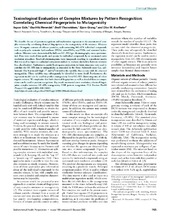Toxicological evaluation of complex mixtures by pattern recognition: Correlating chemical fingerprints to mutagenicity
Journal article
Published version

Åpne
Permanent lenke
https://hdl.handle.net/1956/12168Utgivelsesdato
2002-12Metadata
Vis full innførselSamlinger
- Department of Chemistry [433]
Sammendrag
We describe the use of pattern recognition and multivariate regression in the assessment of complex mixtures by correlating chemical fingerprints to the mutagenicity of the mixtures. Mixtures were 20 organic extracts of exhaust particles, each containing 102-170 individual compounds such as polycyclic aromatic hydrocarbons (PAHs), nitro-PAHs, oxy-PAHs, and saturated hydrocarbons. Mixtures were characterized by full-scan GC-MS (gas chromatography-mass spectrometry). Data were resolved into peaks and spectra for individual compounds by an automated curve resolution procedure. Resolved chromatograms were integrated, resulting in a predictor matrix that was used as input to a principal component analysis to evaluate similarities between mixtures (i.e., classification). Furthermore, partial least-squares projections to latent structures were used to correlate the GC-MS data to mutagenicity, as measured in the Ames Salmonella assay (i.e., calibration). The best model (high r2 and Q2) identifies the variables that co-vary with the observed mutagenicity. These variables may subsequently be identified in more detail. Furthermore, the regression model can be used to predict mutagenicity from GC-MS chromatograms of other organic extracts. We emphasize that both chemical fingerprints as well as detailed data on composition can be used in pattern recognition.